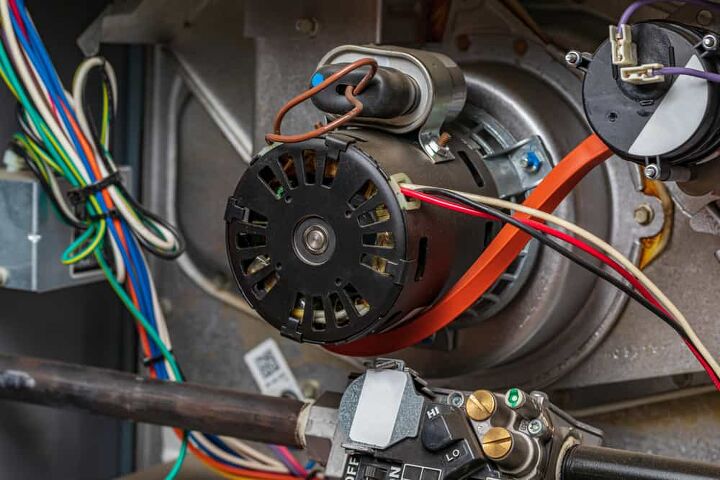Furnace Blower Motor Hums But Won't Start? (We Have A Fix)

A good functioning furnace is essential, especially in the colder months when you want to warm up your home to keep cozy. However, it can be frustrating if your furnace won’t cooperate. It’s pretty standard for furnace blower motors to have issues, but what if the blower motor hums but won’t start?
If your furnace blower motor hums but does not start, this is most likely due to a faulty capacitor. To ensure the capacitor is the issue, you will need to test the capacitor itself before you replace it. This can be done quickly by yourself or by hiring a professional.
This article will talk about the signs of a bad capacitor and how you can diagnose the problem without contacting a professional. Moreover, we’ll provide instructions on how you can test your capacitor to ensure that this is the problem.
Do You Need a Furnace Repair Contractor?
Get free, zero-commitment quotes from pro contractors near you.

Why Is My Blower Motor Humming But Won’t Start?
Humming but refusing to start is not an uncommon problem with furnace blower motors. Most likely, the capacitor is the culprit. This is a small and inexpensive electrical component that’s not difficult to find and replace.
However, a faulty blower motor is another possibility. That would involve more expense, but we’ll start with the capacitator as it’s less common.
There are two kinds of capacitors: Start capacitors and run capacitors. Most newer furnaces only have a run capacitor. Dual-run capacitors found in AC condensing units and packaged heat units run two fans simultaneously – for example, the blower fan and the AC fan.
Can I Replace A Blower Motor Capacitor On My Own?
The most cost-effective way to replace a capacitor is to use a quick DIY fix. If you don’t feel confident to carry out the work, a contractor will, of course, involve more expense.
The fix is relatively easy and friendly for DIY beginners. If we had to rate this on a scale from 1 to 5, with five being the most difficult, we say it’s about a 2.
However, the difficulty depends on what needs to be removed to allow you to access the capacitor bracket. In specific models, it’s immediately accessible. In others, you’d need to remove a panel or control board.
Diagnosing An Issue With My Blower Motor
First, let’s identify the issue.
There could be several signs that something is wrong:
- There’s no air being pushed through the grates, although the blower is humming
- The light is buzzing, but you cant hear the blower fan moving
- The thermostat is set higher than the temperature it’s showing
- No air is flowing
Furnaces typically make a soft humming noise whenever the power is on – however, you need to look out for a louder, buzzing noise.
Troubleshooting A Bad Capacitor
The heavy motor of your furnace blower requires a lot of power to get started. The furnace voltage of 110-120 is insufficient for this task.
The capacitor can provide an extra 400+volts. When this stored power is released, the furnace can start drawing in cold air to provide heat.
Instructions
You could try to get the blower started manually. Here we stress that this is not what we recommend, as it involves serious safety risks. However, as some people choose this option, we’ll explain what they do.
- Gather the equipment you will need, such as a wooden spoon or long screwdriver. On no account, use your fingers – it’s just not safe.
- Figure out the way the blower is facing. Work out which way the blower rotates in operation. You may see a directional arrow on the blower housing, which will help you.
- Turn off the furnace. Next, reduce the temperature on the thermostat, and switch off the furnace using the main switch located on or near the furnace.
- Try rotating the blower fan. Using your selected tool, try and rotate the blower fan in the direction it should turn. If it moves freely, the motor hasn’t seized up. This is a clue that it’s the capacitor creating the malfunction.
- Turn the Fan on. With the furnace still switched off, turn the thermostat to Fan On mode (rather than Auto mode, which is probably the default).
- Power the furnace. Does the hum start again while the fan blades don’t begin rotating?
- Manually spin the Fan. Use the dowel or long screwdriver (never your fingers) to try to start the blades spinning in the direction they should move. You’ll just be providing a little extra energy to get the blower moving.
Does the Blower re-start? If the answer is yes, you’ve identified that the capacitor is almost definitely the issue. If it doesn’t fire up, the motor is probably burned out. That will require a different repair which a qualified furnace repair technician should carry out.
How To Test A Capacitor
If you already have a multimeter and want to be certain that your run capacitor is at fault, it’s quite simple. Just follow the steps below. However, before you go any further, just a word of caution. As we previously mentioned, the run capacitor stores up to 400 volts of additional energy.
Please pay close attention to Step 1 below to avoid an electric shock. It’s also understandable if you prefer to leave this work to a professional – it will ensure no accidents.
Instructions
- Discharge the capacitor. Take an insulated screwdriver, i.e., one which has a rubber, synthetic or plastic handle, and make sure the handle is 100% crack-free. Next, place the screwdriver shaft horizontally across the two terminals. This must be carried out with the furnace switched off and the capacitor still in place.
- Take out the capacitor. Remove the screws which hold the bracket in place. Draw out the capacitor and detach the connectors. This process is also known as ‘shorting.
- Understand the reading you‘re looking for. The capacitor’s rating will be written on it, known as the micro-farad (MFD) number. Typically the label will say something like “+/- 10%. This means that a “good” reading on a 10 MFD capacitor could be 9, 10, or 11 on the multimeter when it’s turned to capacitance (see next step).
- Test the furnace run capacitor. Switch your multimeter dial to the ‘capacitance’ setting. Attach a meter lead to each of the capacitor terminals. Hold them in place and observe the meter. Wait 30-60 seconds. If nothing registers, it means the capacitor is dead. But, if the number does go up, but if after 60 seconds, it hasn’t reached the micro-farad rating (plus/minus 10%), this means it is deteriorating and needs to be replaced.
If the meter reading shows the capacitator is working at the correct capacity, we recommend that you call a technician to service your furnace. He or she will also test each component and give you an estimate for a replacement if required.
Where To Buy A New Capacitor
Furnace run capacitors can be found online at HVAC sites such as RepairClinic.com and SearsPartsDirect.com, and sometimes on Amazon.com. However, they aren’t always easy to find locally. Home improvement stores and hardware stores don’t often stock them.
Local HVAC parts stores often only sell on a wholesale basis to HVAC companies, so you’d have to be prepared to do some searching to locate the part you want at the right price.
Furnace Capacitor Cost
The price will typically be anything from $5 to $20. It’s worth bearing in mind that your capacitor may fail at some point.
It makes sense to invest in a spare (and also an extra igniter) so that in case of need, you can replace it immediately. While this isn’t necessary, most people find it convenient not to scramble to locate the part they need.
To have a furnace capacitor installed by a qualified HVAC technician can cost anything from $80 to $200. Expect a minimum fee of $75, even though the part is inexpensive and the repair can be completed between 5 -20 minutes.
If you need the repair carried out at night, or the weekend, expect to pay more. If there’s no danger of additional damage due to frozen pipes, it will save you money if the repair is carried out during regular working hours.
Where To Buy A Furnace Blower Motor
Unlike capacitors, you can usually find furnace blower motors at your local Home Depot or Lowes. Just get the model number of your blower motor and call the store so they can order it for you.
What Does A Furnace Blower Motor Cost?
On average, a furnace blower motor will cost you around $450. However, this price can fluctuate from $200 up to $800. The price depends on the model of your furnace, as well as the size. For instance, the blower motor, an industrial type furnace, will be around $800, if not more.
Having an HVAC technician install can cost you between $500 to $1,200, depending on the size of the job and who you hire. This is why it’s a good idea to call around for prices before hiring someone.
Do You Need a Furnace Repair Contractor?
Get free, zero-commitment quotes from pro contractors near you.

Our Takeaway
When your furnace refuses to start but hums anyway, this can be frustrating. However, it’s most likely your capacitor, which is an easy fix.
By walking through to test the capacitor and the blower motor, you will be able to tell what the problem is so that you can fix it and have your furnace working like it’s brand new.

Heather is a passionate writer who loves anything DIY. Growing up, she learned everything from home repairs to design, and wants to share her tips with you. When she's not writing, she's usually hiking or searching for her next DIY project.
More by Heather Robbins










![10 Best Electric Pressure Washers – [2022 Reviews & Guide]](https://cdn-fastly.upgradedhome.com/media/2023/07/31/9070600/10-best-electric-pressure-washers-2022-reviews-guide.jpg?size=350x220)

![The 5 Best Angle Grinders – [2022 Reviews & Buyer's Guide]](https://cdn-fastly.upgradedhome.com/media/2023/07/31/9071326/the-5-best-angle-grinders-2022-reviews-buyer-s-guide.jpg?size=350x220)









![10 Most Dangerous Neighborhoods in Baltimore [Updated]](https://cdn-fastly.upgradedhome.com/media/2023/07/31/9075655/10-most-dangerous-neighborhoods-in-baltimore-updated.jpg?size=350x220)




